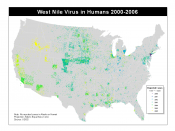Historical:
West Nile virus was first isolated from an adult woman in the West Nile District of Uganda in 1937. The ecology was characterized in Egypt in the 1950s. The virus became recognized as a cause of severe human meningoencephalitis (inflammation of the spinal cord and brain) in elderly patients during an outbreak in Israel in 1957. Equine disease was first noted in Egypt and France in the early 1960s. The first appearance of WN virus in North America in 1999, with encephalitis reported in humans and horses, and the subsequent spread in the United States may be an important milestone in the evolving history of this virus.
Description of Disease:
West Nile Virus" is a flavivirus commonly found in Africa, West Asia, and the Middle East. It is closely related to St. Louis encephalitis virus found in the United States. The virus can infect humans, birds, mosquitoes, horses and some other mammals.
Age Group Most Affected:
While all residents of areas where virus activity has been identified are at risk of getting West Nile encephalitis; persons over 50 years of age have the highest risk of severe disease. It is unknown whether people suffering from autoimmune disorders are at increased risk for West Nile Virus.
Cause of disease:
West Nile Virus is an "arbovirus" that causes encephalitis (inflammation to the brain). Blood-feeding insects such as mosquitoes transmit these viruses. Mosquitoes draw the virus from infected birds and transmit it to animals and humans through bites. During the incubation period the West Nile Virus multiplies in the persons' blood system and crosses the blood brain barrier to reach the brain. The virus interferes with normal central nervous system functioning and causes inflammation of brain tissue. A person contracting WNV is assumed to develop an immunity that will be lifelong, but...



Comments
I agree with bgiff1010. This is an extremely informative essay. Short and to the point while determining many important aspects of the disease.
However I wouldve liked to know its current status with the areas most effected and in what ways.
7 out of 7 people found this comment useful.